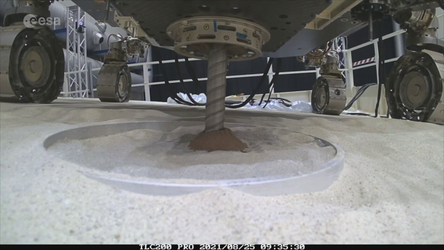Accept all cookies Accept only essential cookies See our Cookie Notice

About ESA
The European Space Agency (ESA) is Europe’s gateway to space. Its mission is to shape the development of Europe’s space capability and ensure that investment in space continues to deliver benefits to the citizens of Europe and the world.
Highlights
ESA - United space in Europe
This is ESA ESA facts Member States & Cooperating States Funding Director General Top management For Member State Delegations European vision European Space Policy ESA & EU Responsibility & Sustainability Annual Report Calendar of meetings Corporate newsEstablishments & sites
ESA Headquarters ESA ESTEC ESA ESOC ESA ESRIN ESA EAC ESA ESAC Europe's Spaceport ESA ESEC ESA ECSAT Brussels Office Washington OfficeWorking with ESA
Business with ESA ESA Commercialisation Gateway Law at ESA Careers Cyber resilience at ESA IT at ESA Newsroom Partnerships Merchandising Licence Education Open Space Innovation Platform Integrity and Reporting Administrative Tribunal Health and SafetyMore about ESA
History ESA Historical Archives Exhibitions Publications Art & Culture ESA Merchandise Kids Diversity ESA Brand Centre ESA ChampionsLatest
Space in Member States
Find out more about space activities in our 23 Member States, and understand how ESA works together with their national agencies, institutions and organisations.
Science & Exploration
Exploring our Solar System and unlocking the secrets of the Universe
Go to topicAstronauts
Missions
Juice Euclid Webb Solar Orbiter BepiColombo Gaia ExoMars Cheops Exoplanet missions More missionsActivities
International Space Station Orion service module Gateway Concordia Caves & Pangaea BenefitsLatest
Space Safety
Protecting life and infrastructure on Earth and in orbit
Go to topicAsteroids
Asteroids and Planetary Defence Asteroid danger explained Flyeye telescope: asteroid detection Hera mission: asteroid deflection Near-Earth Object Coordination CentreSpace junk
About space debris Space debris by the numbers Space Environment Report In space refuelling, refurbishing and removingSafety from space
Clean Space ecodesign Zero Debris Technologies Space for Earth Supporting Sustainable DevelopmentLatest
Applications
Using space to benefit citizens and meet future challenges on Earth
Go to topicObserving the Earth
Observing the Earth Future EO Copernicus Meteorology Space for our climate Satellite missionsCommercialisation
ESA Commercialisation Gateway Open Space Innovation Platform Business Incubation ESA Space SolutionsLatest
Enabling & Support
Making space accessible and developing the technologies for the future
Go to topicBuilding missions
Space Engineering and Technology Test centre Laboratories Concurrent Design Facility Preparing for the future Shaping the Future Discovery and Preparation Advanced Concepts TeamSpace transportation
Space Transportation Ariane Vega Space Rider Future space transportation Boost! Europe's Spaceport Launches from Europe's Spaceport from 2012Latest
ExoMars rover comes out of the ‘oven’
Thank you for liking
You have already liked this page, you can only like it once!
The Rosalind Franklin rover that will search for life on Mars has completed an important bakeout to help clean the rover from organic molecules from Earth.
The rover sat inside a vacuum chamber for 120 hours at 35ºC at the Thales Alenia Space facility in Rome, Italy. The temperature is enough to sublimate hidden contaminants generated by the off-gassing of some of the rover’s internal parts, such as small bits of glue. The goal is to reduce as much as possible any contamination signature of Earth origin, to allow a clean detection of organic compounds on Mars.
An additional analysis following the bakeout will be completed at a later date. That is, the rover’s Mars Organics Molecule Analyser (MOMA), one of the instruments inside the rover’s analytical laboratory ultra-clean zone that will be used to determine if signs of life are present in the martian soil, will determine the chemical background in the rover’s laboratory by performing a measurement using an empty oven. Once on Mars, MOMA’s tiny ovens will host crushed soil samples that will be heated to allow the resulting vapour and gases to be analysed with gas chromatography techniques to sniff out traces of organic compounds. The ‘sniff’ of the empty oven following the Earth-based bakeout will establish the background footprint against which future measurements on Mars can be compared.
The rover is equipped with a unique drill that will bore down to 2 m below the martian surface and return samples for analysis. In the video, the rover is seen with its drill box in horizontal stowed position at the front. The drill tool also hosts a miniaturized spectrometer (Ma_MISS) to analyse the inner surface of the borehole, and a close-up imager (CLUPI) that will look at the drill fines and core sample before it enters the rover’s laboratory.
Different instruments will work together to analyse the samples inside the rover. In addition to MOMA, the MicrOmega instrument will use visible and infrared light to characterise minerals in the samples, and a Raman spectrometer will use a laser to identify mineralogical composition.
Using its panoramic and high resolution cameras and ground-penetrating radar, the ExoMars rover will seek out the most promising locations to drill, and to better understand the geological context of the Oxia Planum region that it will explore.
Following completion of the bakeout, the thermo-vacuum chamber was re-pressurised and opened, and the rover prepared for its return journey to Thales Alenia Space in Turin. There, readiness for launch will continue until it ships to the launch site next year.
Parts of the video are shown as timelapse.
-
CREDIT
Thales Alenia Space -
LICENCE
ESA Standard Licence
-
Closed captions available Captions and subtitles are available (automatically generated by YouTube) - select your language using the YouTube player controls. A non-YouTube version is available using the 'download' button above.
-
Interior Shot
-
-
-
-
-

Moving the ExoMars Analytical Laboratory Drawer

ExoMars Analytical Laboratory Drawer

Martian ovens

ExoMars deep drilling success on Earth















 Germany
Germany
 Austria
Austria
 Belgium
Belgium
 Denmark
Denmark
 Spain
Spain
 Estonia
Estonia
 Finland
Finland
 France
France
 Greece
Greece
 Hungary
Hungary
 Ireland
Ireland
 Italy
Italy
 Luxembourg
Luxembourg
 Norway
Norway
 The Netherlands
The Netherlands
 Poland
Poland
 Portugal
Portugal
 Czechia
Czechia
 Romania
Romania
 United Kingdom
United Kingdom
 Slovenia
Slovenia
 Sweden
Sweden
 Switzerland
Switzerland
























